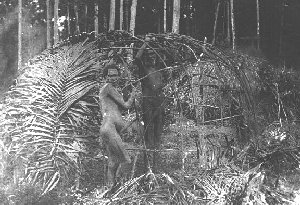Rainforest Shelters - Ngadjon
Note: this site contains images of aboriginal people now deceasedRainforest Shelters of the Ngadjon

Photo courtesy Eacham Historical Society
The Ngadjonji moved about from camp to camp within their territory according to where food was plentiful in each season. In their camps they constructed snug rainproof shelters (mija) or repaired ones which were there from their last stay. The photo (above) was taken in Malanda in the 1930's and shows a group of Ngadjonji in front of three well-constructed mija.

Photo courtesy Cairns Historical Society
The early photograph shows a mija during construction. (For a higher resolution version of this photograph click here) The main frame usually consisted of sturdy lengths of jungganyu bent over and stuck in the ground at each end to form a series of arches. Horizontal crosspieces were then woven between these arches and tied in place with barrga ties. The mija was then thatched with suitable leaves (jungganyu and bibiya were particularly favoured) to form the rain- and wind-proof cover.
The Ngadjonji also made blankets (badugi) from the inner bark of certain fig trees (gabi and magurra) which could be wrapped around the body for warmth on cold winter nights. A strip of bark was cut from the tree, the outer layers removed and the moist supple inner layer beaten out over a broad tree root to soften the fibres and spread out the blanket. The blankets were often decorated with ochre patterns.
In the wet season the Ngadjon lived in large huts up to 9m long and 3m high and and fed on rainforest nuts harvested earlier and stored under damp climate controlled conditions - enough food to feed maybe 30 people for three or four months.
Food preparation for some nuts(being toxic) was complex and could begin as much as 4 days before the food was to be consumed.

